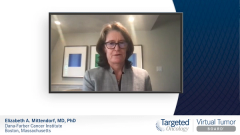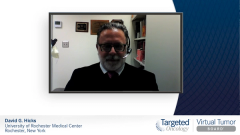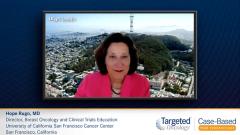
Case 3: Precision Medicine in Metastatic Breast Cancer
Experts in the field of breast cancer review the role of genetic testing in the selection of treatment for patients with TNBC.
Episodes in this series

Elizabeth A. Mittendorf, MD, PhD: As we’ve pointed out, we’re focusing on metastatic and triple-negative breast cancer, but there’s a fair percentage of metastatic-positive breast cancer. When I talk about sending off for sequencing and a PIK3CA mutation, that’s probably a little more common with hormone receptor–positive disease. What’s the current status of targeting—which you alluded to earlier—for targeting PIK3CA mutations therapeutically in patients?
Ruta Rao, MD: In the ER [estrogen receptor]–positive metastatic breast cancer setting, we have alpelisib [Piqray] for patients who carry those mutations. The mutations are seen in about 40% of patients, and my understanding—David, correct me if you know different—is that the PIK3CA mutation is stable in the tumor over time. You could have tested it on the primary tumor or the metastatic site, particularly speaking to ER-positive, in those patients.
David G. Hicks, MD: That’s my understanding too.
Ruta Rao, MD: Another important point to keep in mind in the ER-positive setting is that some percentage of patients lose their ER-positivity. Sometimes I will rebiopsy those patients if I’m seeing a mixed response or tumor growing in 1 area and shrinking in other areas. Recently, I had a young woman whose tumor in her breast tissue is responding nicely to hormonal therapy, but she developed a new lesion in the liver at the same time. I biopsy that, and sure enough that showed that it was triple-negative in the liver.
David G. Hicks, MD: There’s another issue. Historically, the threshold for ER positivity is 1% or greater of cells that are ER-positive. Historically, pathologists were generous in trying to say, “Let’s see if we can make this breast cancer ER-positive,” because it will give them something to treat when they probably shouldn’t be. Now we have immunotherapy, PARP inhibitors, and sacituzumab. Ruta, our medical oncologists hate it when we say 2% weekly ER-positive, because it’s a high-grade tumor. It’s inflamed, there’s necrosis, and nobody thinks it’s going to act like an ER-positive breast cancer responding to endocrine therapy. There was a discussion when the ER guidelines were made that we should set the threshold back to 10% or more for ER-positivity. Interestingly, that got voted down by the medical oncologist on the panel because they were worried about missing ER-positives. Does that weekly ER-positive put you in a bind? Many of those patients are probably more appropriately treated as triple-negative.
Ruta Rao, MD: Actually, 1 location or 1 setting in which it really puts us in a bind is when we’re considering these patients for clinical trials. A lot of the clinical trial inclusion or exclusion criteria say this is for a patient with triple-negative breast cancer. If we get this patient who has an invasive cancer—grade 3, ER 2%, PR [progesterone recepotor] 0, HER2-negative, their KI67 is high—we all agree that this feels and smells like triple-negative breast cancer. But then you get frustrated that they’re excluded from some of these clinical trials, and then you have to talk to the sponsor. It makes it a little hard. Beth, do you agree about that piece of it?
Elizabeth A. Mittendorf, MD, PhD: Absolutely. In fact, when David started speaking, my question to you was going to be the same thing, but your response suggested that’s your challenge as well.
Transcript edited for clarity.














































